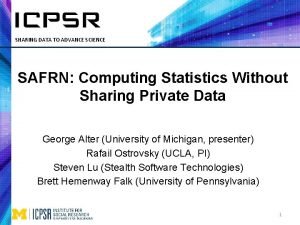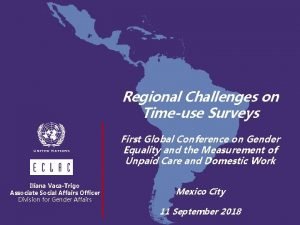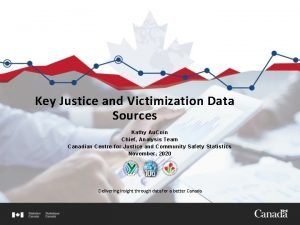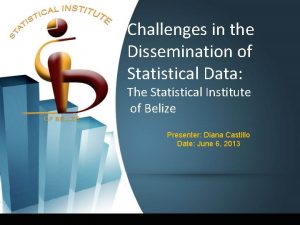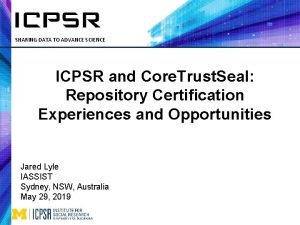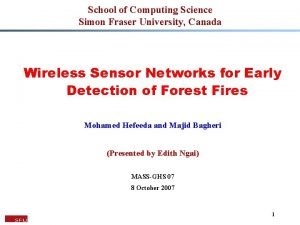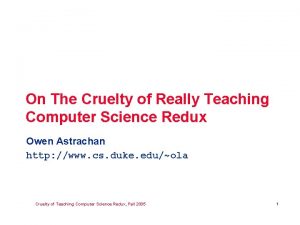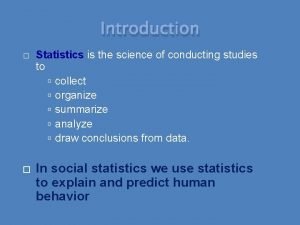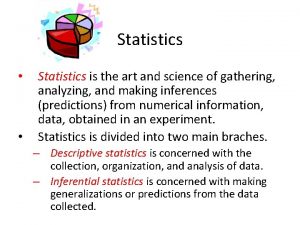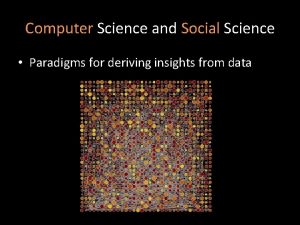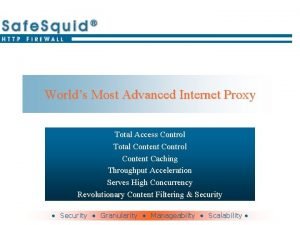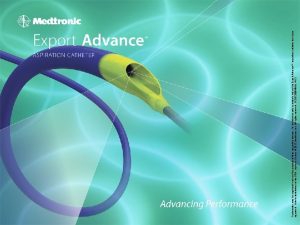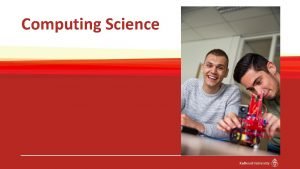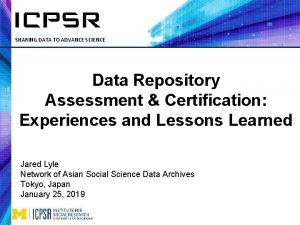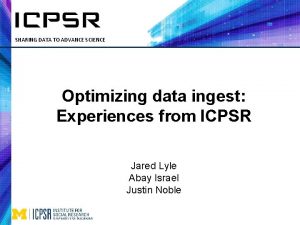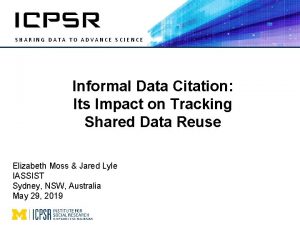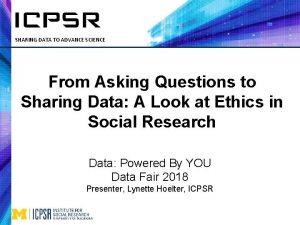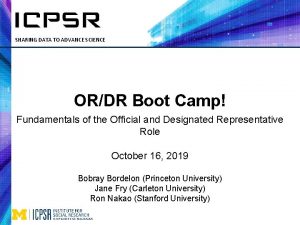SHARING DATA TO ADVANCE SCIENCE SAFRN Computing Statistics




















- Slides: 20

SHARING DATA TO ADVANCE SCIENCE SAFRN: Computing Statistics Without Sharing Private Data George Alter (University of Michigan, presenter) Rafail Ostrovsky (UCLA, PI) Steven Lu (Stealth Software Technologies) Brett Hemenway Falk (University of Pennsylvania) 1

SAFRN: Secure Analytics for Reticent Non-consolidated Databases • Goal: Statistics from multiple private databases computed by Secure Multiparty Computing • Grant from the Laura and John Arnold Foundation • Primary grantee: Stealth Software Technologies • Rafail Ostrovsky (UCLA) PI • Subcontract to ICPSR, University of Michigan 2

How are confidential data shared? • Anonymization (e. g. HIPAA rules) • Data use agreements • Protected environments (physical, virtual) • Trusted brokers All of these solutions assume that the data exist in a single place • Data from multiple sources are together in a combined dataset 3

Why use Secure Multi-party Computation? • Computing summary statistics from multiple confidential sources • Records must be linked or aggregated across databases • Databases cannot reveal individual-level (unit record) information to each other or anyone else • Perform like a trusted broker without ever collecting data in one place 4

MPC and public policy “The Commission believes that improved access to data under more privacy-protective conditions can lead to an increase in both the quantity and the quality of evidence to inform important program and policy decisions. ” Report of the Commission on Evidence-Based Policymaking, September 2017 5

MPC appears in proposed legislation Senator Ron Wyden (Oregon): “Student Right to Know Before You Go Act” 6

History of MPC • Theoretical works from the 80 s showed that any function can be computed securely (Yao, Goldreich. Micali-Wigderson, Ben Or-Goldwasser-Wigderson, Chaum-Crépeau. Damgård, …) • Long line of works over the past few decades to make MPC more efficient and usable • Danish Sugar Beet Auction using MPC • It’s been 10 years now! • Many other examples (Taulbee Salary Survey Attempt, Estonian Financial Data, Boston Wage Study, …) 7

How does MPC work? 8 Average Income? Three people with true salaries S 1, S 2, S 3 they never reveal. Each computes random numbers Rij to give the other two. Each shares salary plus Rij given minus Rij received, i. e. , + X 1 = S 1 + (R 12 + R 13) – (R 21 + R 31) X 2 = S 2 + (R 21 + R 23) – (R 12 + R 32) X 3 = S 3 + (R 31 + R 32) – (R 13 + R 23) Sum = S 1 + S 2 + S 3 MPC becoming more widespread: Daniel Goroff from the Alfred P. Sloan Foundation presented this classic example

How does MPC work? 9 Average Income? Three people with true salaries S 1, S 2, S 3 they never reveal. Each computes random numbers Rij to give the other two. Each shares salary plus Rij given minus Rij received, i. e. , Only encrypted data are revealed. + X 1 = S 1 + (R 12 + R 13) – (R 21 + R 31) X 2 = S 2 + (R 21 + R 23) – (R 12 + R 32) X 3 = S 3 + (R 31 + R 32) – (R 13 + R 23) Sum = S 1 + S 2 + S 3 MPC becoming more widespread: Daniel Goroff from the Alfred P. Sloan Foundation presented this classic example

How does MPC work? 10 Average Income? Three people with true salaries S 1, S 2, S 3 they never reveal. Each computes random numbers Rij to give the other two. Each shares salary plus Rij given minus Rij received, i. e. , Only encrypted data are revealed. + X 1 = S 1 + (R 12 + R 13) – (R 21 + R 31) X 2 = S 2 + (R 21 + R 23) – (R 12 + R 32) X 3 = S 3 + (R 31 + R 32) – (R 13 + R 23) Data owners hold their own encryption keys. Sum = S 1 + S 2 + S 3 MPC becoming more widespread: Daniel Goroff from the Alfred P. Sloan Foundation presented this classic example

How does MPC work? • Data owners control their own data • Only encrypted data are released • The data owner does the encryption • The data owner holds the encryption keys • No one sees unencrypted data • Encrypted data are transmitted openly • Security characteristics of the MPC system can be demonstrated mathematically • Calculated results are exact • Security comes from encryption not from adding noise • Calculations can be done in real time

What doesn’t MPC do? • MPC outputs may reveal information about an individual • Suppose that we compute average income by occupation, age, and state of residence • There may be only one US Senator over age 65 from Oregon • MPC can be combined with other measures (differential privacy) to assure that results do not identify individuals 12

Limitations of MPC • MPC cannot be added to existing statistical software • MPC algorithms must be engineered into software from the start • Computations in MPC may be expensive • MPC computations produce a large volume of encrypted messages between databases • Costs of MPC are difficult to estimate, because they depend on the data 13

SAFRN Project Goals • Demonstrate MPC for computing statistics from multiple private databases • Descriptive statistics (e. g. crosstabulation, average) • Analytic statistics (e. g. multiple regression) • Document MPC algorithms • Estimate costs of MPC using realistic data • Synthetic data created from national surveys 14

SAFRN Prototype Secure Analytics for Reticent Non-consolidated Databases • 7 servers • 4 Schools • 5 Degrees • Income server • 3 Income variables: 2, 3, and 10 years after graduation • Loans • Analyst requests statistics • Computes average incomes and loans by School and Degree • Synthetic data 1 K to 10 M cases 15

SAFRN Prototype School 1 Database Users MPC App SQL Analyst Interface Web Server School 2 Database Management Gateway/Front Server MPC App SQL User Interface MPC App Income Database School 3 Database MPC App SQL Loan Database School 4 Database MPC App SQL SQL

SAFRN Prototype Funded by 17

SAFRN Prototype Funded by 18

SAFRN Team • Stealth Software Technologies • Rafail Ostrovsky (PI) • Paul Bunn • Brett Hemenway Falk • Yuval Ishai • Steve Lu • ICPSR participants • George Alter (co-PI) • Srujith Cheruku • Michael Elliott • Stuart Hutchings • John Marcotte • Dan Pritts • Kristine Witkowski 19

Thank you! George Alter altergc@umich. edu http: //www. stealthsoftwareinc. com/ Funded by 20
 Safrn
Safrn Advance statistics
Advance statistics Advance statistics
Advance statistics Advance statistics
Advance statistics Advance science
Advance science Paragraph on my favourite subject science
Paragraph on my favourite subject science Conventional computing and intelligent computing
Conventional computing and intelligent computing Introduction to statistics what is statistics
Introduction to statistics what is statistics Komunikasi data merupakan gabungan dua macam teknik yaitu
Komunikasi data merupakan gabungan dua macam teknik yaitu Sharing data
Sharing data Improved data sharing in dbms
Improved data sharing in dbms Advanced higher computing understanding standards
Advanced higher computing understanding standards Sfu computing science
Sfu computing science On the cruelty of really teaching computer science
On the cruelty of really teaching computer science Definition of empirical evidence
Definition of empirical evidence What is a population parameter
What is a population parameter Statistics for social science
Statistics for social science Proxy advance most
Proxy advance most The cross legged captive
The cross legged captive катетер export advance
катетер export advance What are the types of advance directives
What are the types of advance directives
